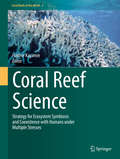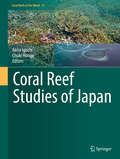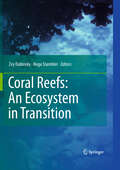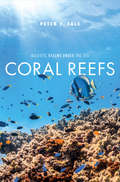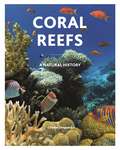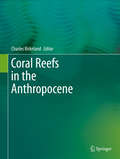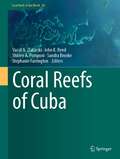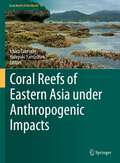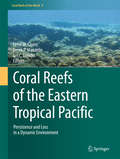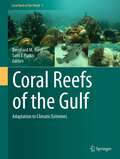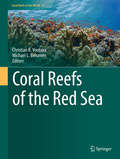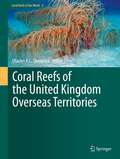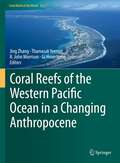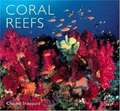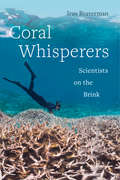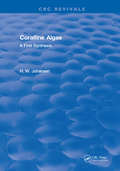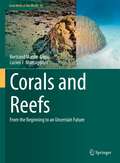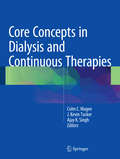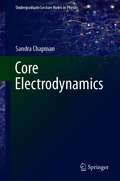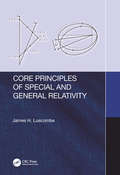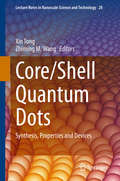- Table View
- List View
Coral Reef Science: Strategy for Ecosystem Symbiosis and Coexistence with Humans under Multiple Stresses (Coral Reefs of the World #5)
by Hajime KayanneThis book aims to illuminate coral reefs which comprise a symbiotic system coexisting among ecosystems, landforms, and humans at various levels and to provide a scientific basis for its reconstruction. The authors conducted an interdisciplinary project called "Coral Reef Science" from 2008 to 2012 and obtained novel results and clues to unite different disciplines for a coral reef as a key ecosystem.
Coral Reef Studies of Japan (Coral Reefs of the World #13)
by Akira Iguchi Chuki HongoThis book comprehensively introduces recent important studies on coral reefs from various research fields including biology, ecology, chemistry, the earth sciences, and conservation studies. Coral reef is one of the important ecosystems characterized by high biodiversity and the beauty. Coral reefs around Japan are located at the northern limit, composed by mainly fringing reefs along archipelago, and easily impacted by human activities. Thus, coral reef studies around Japan have provided important knowledge on basic sciences and conservation studies regarding coral reef ecosystem. This book would contribute to systematic understanding of vulnerable coral reef ecosystems due to human activities in the Indo-Pacific and Caribbean regions. The conservation efforts provide good reference to graduate and undergraduate students, and researchers in marine sciences, as well as those who are involved in coral reef studies.
Coral Reefs: An Ecosystem In Transition
by Zvy Dubinsky Noga StamblerThis book covers in one volume materials scattered in hundreds of research articles, in most cases focusing on specialized aspects of coral biology. In addition to the latest developments in coral evolution and physiology, it presents chapters devoted to novel frontiers in coral reef research. These include the molecular biology of corals and their symbiotic algae, remote sensing of reef systems, ecology of coral disease spread, effects of various scenarios of global climate change, ocean acidification effects of increasing CO2 levels on coral calcification, and damaged coral reef remediation. Beyond extensive coverage of the above aspects, key issues regarding the coral organism and the reef ecosystem such as calcification, reproduction, modeling, algae, reef invertebrates, competition and fish are re-evaluated in the light of new research and emerging insights. In all chapters novel theories as well as challenges to established paradigms are introduced, evaluated and discussed. This volume is indispensible for all those involved in coral reef management and conservation.
Coral Reefs: Majestic Realms under the Sea
by Peter F. SaleAn eye-opening introduction to the complexity, wonder, and vital roles of coral reefs When mass coral bleaching and die†‘offs were first identified in the 1980s, and eventually linked to warming events, the scientific community was sure that such a dramatic and unambiguous signal would serve as a warning sign about the devastating effects of global warming. Instead, most people ignored that warning. Subsequent decades have witnessed yet more degradation. Reefs around the world have lost more than 50 percent of their living coral since the 1970s. In this book, distinguished marine ecologist Peter F. Sale imparts his passion for the unexpected beauty, complexity, and necessity of coral reefs. By placing reefs in the wider context of global climate change, Sale demonstrates how their decline is more than simply a one†‘off environmental tragedy, but rather an existential warning to humanity. He offers a reframing of the enormous challenge humanity faces as a noble venture to steer the planet into safe waters that might even retain some coral reefs.
Coral Reefs: A Natural History
by Charles SheppardAn illustrated look at corals and the reefs they build around the world, and the causes and dire consequences of their rapid disappearanceCorals are among the most varied lifeforms on Earth, ranging from mushroom corals and leather corals to button polyps, sea fans, anemones, and pulse corals. Bridging the gap between plant and animal, these marine invertebrates serve as homes to reef fish and share symbiotic relationships with photosynthesizing algae, which provide corals with their nourishment. This stunningly illustrated book profiles the astonishing diversity of the world's coral groups, describing key aspects of their natural history and explaining why coral reefs are critical to the health of our oceans. Representative examples of corals have been selected to illustrate the broad range of species, and the book's lively and informative commentary covers everything from identification to conservation, making it an essential resource for marine biologists, divers, and anyone who is fascinated by these remarkable sea creatures.Features more than 200 exquisite color photosHighlights key aspects of corals and their natural historyFeatures representative examples from around the worldIncludes photos of rare and unusual species
Coral Reefs in the Anthropocene
by Charles BirkelandThis volume investigates the effects of human activities on coral reefs, which provide important life-supporting systems to surrounding natural and human communities. It examines the self-reinforcing ecological, economic and technological mechanisms that degrade coral reef ecosystems around the world. Topics include reefs and limestones in Earth history; the interactions between corals and their symbiotic algae; diseases of coral reef organisms; the complex triangle between reef fishes, seaweeds and corals; coral disturbance and recovery in a changing world. In addition, the authors take key recent advances in DNA studies into account which provides new insights into the population biology, patterns of species distributions, recent evolution and vulnerabilities to environmental stresses. These DNA analyses also provide new understandings of the limitations of coral responses and scales of management necessary to sustain coral reefs in their present states. Coral reefs have been essential sources of food, income and resources to humans for millennia. This book details the delicate balance that exists within these ecosystems at all scales, from geologic time to cellular interactions and explores how recent global and local changes influence this relationship. It will serve as an indispensable resource for all those interested in learning how human activities have affected this vital ecosystem around the world.
Coral Reefs of Cuba (Coral Reefs of the World #18)
by Vassil N. Zlatarski John K. Reed Shirley A. Pomponi Sandra Brooke Stephanie FarringtonThis comprehensive volume gathers foremost experts on the coral reefs of Cuba who represent a spectrum of disciplines, including biology, conservation ecology, economics and geology. The volume is organized along general themes including the Cuban Reef biota, reefs occurring in the Mesophotic and Eutrophic zones, ecology, conservation, management and the economic importance of the coral reefs of Cuba. The combination of case studies, new and previously published research, historical overview and examples of the ways in which research has contributed to the management and conservation of Cuban coastal resources provides a unique reference for graduate students and professionals holding a wide range of interests and expertise related to coral reef systems.
Coral Reefs of Eastern Asia under Anthropogenic Impacts (Coral Reefs of the World #17)
by Ichiro Takeuchi Hideyuki YamashiroCoral reefs, which are one of the most productive and biodiverse ecosystems on Earth, serve various important roles, such as providing shelter and spawning grounds to a wide range of marine animals. However, the global decline of hard corals in tropical and subtropical regions is a growing concern. A recent review of the Intergovernmental Panel on Climate Change (IPCC) indicated that only 10%–30% of coral reefs would survive with an increase of 1.5 °C in global warming temperature. Of coral reefs around the world, the coral reefs in eastern Asia face one of the most industrially developed and high population areas in the world. Thus, coral reefs of eastern Asia have been affected by various anthropogenic factors, such as eutrophication, coastal development, anthropogenic pollutants, ocean acidification, disease, and overfishing. Therefore, urgent research is required to determine the levels at which different factors will affect coral health. Besides, we propose a perspective on coral reef (especially those in eastern Asia) conservation under climate change and various anthropogenic activities.
Coral Reefs of the Eastern Tropical Pacific: Persistence and Loss in a Dynamic Environment (Coral Reefs of the World #8)
by Peter W. Glynn Derek P. Manzello Ian C. EnochsThis book documents and examines the state of health of coral reefs in the eastern tropical Pacific region. It touches on the occurrence of coral reefs in the waters of surrounding countries, and it explores their biogeography, biodiversity and condition relative to the El Niño southern oscillation and human impacts. Additionally contained within is a field that presents information on many of the species presented in the preceding chapters.
Coral Reefs of the Gulf: Adaptation to Climatic Extremes (Coral Reefs of the World #3)
by Sam J. Purkis Bernhard M. RieglCoral Reefs of the Gulf: Adaptation to Climatic Extremes is a complete review and reference for scientists, engineers and students concerned with the geology, biology or engineering aspects of coral reefs in the Middle East. It provides for the first time a complete review of both the geology and biology of all extant coral areas in the Gulf, the water body between Iran and the Arabian Peninsula. In summer, this area is the hottest sea with abundant coral growth on earth and already today exhibits a temperature that is predicted to occur across the topical ocean in 2100. Thus, by studying the Gulf today, much can be learned about tomorrow's world and the capability of coral reefs to adapt to climatic extremes. This volume provides the most authoritative and up-to-date review of the coral reefs in the Gulf. It can be used as a volume of general reference or as a textbook treating recent coral reefs. Written by local and international experts, the text is richly illustrated and will remain a standard reference for the region for decades to come. Contributions stretch from climatology through geology, biology, ecological modelling and fisheries science to practical conservation aspects. The book is useful for the technical expert and casual reader alike.
Coral Reefs of the Red Sea (Coral Reefs of the World #11)
by Christian R. Voolstra Michael L. BerumenThis volume is a complete review and reference work for scientists, engineers, and students concerned with coral reefs in the Red Sea. It provides an up-to-date review on the geology, ecology, and physiology of coral reef ecosystems in the Red Sea, including data from most recent molecular studies. The Red Sea harbours a set of unique ecological characteristics, such as high temperature, high alkalinity, and high salinity, in a quasi-isolated environment. This makes it a perfect laboratory to study and understand adaptation in regard to the impact of climate change on marine ecosystems. This book can be used as a general reference, guide, or textbook.
Coral Reefs of the United Kingdom Overseas Territories (Coral Reefs of the World)
by Charles R.C. SheppardThe tropical UK Territories have extensive coral reefs. Huge parts of these areas are exceptionally rich, productive and diverse. Their marine biodiversity exceeds that of the UK itself, and several are already, or are planned to be, strictly protected. Some of these areas serve as reference sites for many other countries with damaged reefs and they are oases of tropical marine biodiversity in a fast-degrading world. This book reviews all of the UK reefs, from those scarcely known to those where substantial research has already been performed.
Coral Reefs of the Western Pacific Ocean in a Changing Anthropocene (Coral Reefs of the World #14)
by Jing Zhang Thamasak Yeemin R. John Morrison Gi Hoon HongThe monograph is based on the research and training activities in the Western Pacific Ocean Region within the umbrella of UNESCO/IOC-Sub-Commission for the Western Pacific Region. The results of these activities are compared to cases from other tropical and subtropical regions on this planet to make the knowledge applicable to global aspects of sustainability of coral reef ecosystems. In this monograph, we examine the coral reefs from viewpoint of multidisciplinary approaches, including, environmental impacts, coral biology and system ecology, biogeochemical cycles and processes that drive the material and energy flow through the food web, as well as the proxies in geochemistry that have been used to track the responses of coral reefs to the changing climate and human perturbations. Although this study is focused on the Western Pacific Ocean, the Western Pacific Ocean is so large and diverse that most reef environment types on this planet are located within it. Therefore, knowledge gained in this study is relevant to the application of coastal management in practice as well as in the teaching classes on the interactions between coral reef ecosystems with changing environments.
Coral Reefs (WorldLife Library)
by Charles SheppardCoral reefs are one of the wonders of the natural world. Protecting thousands of miles of shoreline from erosion, these intricate structures support biodiversity essential to the balance of the world's ecosystems. They are one of nature's most significant and ancient infrastructures. Global warming and our overuse of the reefs is causing untold damage to these beautiful yet fragile formations. In this lavishly illustrated book, Dr. Charles Sheppard explores the underwater world of coral reefs. Using popular examples from around the world, he explains how these vast constructs function and what must be done to save them.
Coral Whisperers: Scientists on the Brink (Critical Environments: Nature, Science, and Politics #3)
by Irus BravermanIn recent years, a catastrophic global bleaching event devastated many of the world’s precious coral reefs. Working on the front lines of ruin, today’s coral scientists are struggling to save these important coral reef ecosystems from the imminent threats of rapidly warming, acidifying, and polluted oceans. Coral Whisperers captures a critical moment in the history of coral reef science. Gleaning insights from over one hundred interviews with leading scientists and conservation managers, Irus Braverman documents a community caught in an existential crisis and alternating between despair and hope. In this important new book, corals emerge not only as signs and measures of environmental catastrophe, but also as catalysts for action.
Coralline Algae: A First Synthesis
by H.W. JohansenThis book is the first step at pulling together the voluminous but scattered information on coralline algae. Much can be said about these omnipresent plants of the sea, and the purpose here is to provide a coherent frame work of data and discussion.
Corals and Reefs: From the Beginning to an Uncertain Future (Coral Reefs of the World #16)
by Bertrand Martin-Garin Lucien F. MontaggioniThe health status and future of tropical coral reefs, as tourist destinations, are regularly subjected to media coverage. Many documentaries recognize the natural beauty and biological richness of the Australian Great Barrier Reef and French Polynesian lagoons, but point to the equally significant risk that would result from current global warming and human-made hazards. The future of coral reefs is usually a matter of death foretold, real or purely imaginary. In this context, it has become necessary to differentiate between what is falling within reality of scientific facts or fantasy. To this end, the present general review, in the expert translation of Charlotte Fontan aims at: (1) defining the conditions and life requirements of reefbuilding corals; (2) the history of corals along with that of a number of associated, skeletal organisms involved in reef building since the very beginning, i.e. the last 540 million years, including the ups and downs they have experienced; (3) giving special reference to the development patterns of recent and modern reefs; (4) projecting corals and reefs into a still unknown future. Understanding how corals and reefs have originated, how they have been able to face the major biological crises which have punctuated the Earth’s history, how they have survived is a prerequisite to better gain a significant picture of their future.
Core Concepts in Dialysis and Continuous Therapies
by Ajay K. Singh Colm C. Magee J. Kevin TuckerThis clinically focused and authoritative guide to managing End Stage Renal Disease (ESRD) patients provides the essentials of hemodialysis, peritoneal dialysis, and continuous therapies. Chapters cover the technical aspects of delivering dialysis therapy, clinical care of patients on dialysis and the evaluation and management of common complications of kidney failure in patients of dialysis - including anemia, bone disease and hypertension. Authored by worldwide leading experts in the field, this book is an invaluable resource for nephrologists and other healthcare professionals involved in dialysis treatment or caring for the ESRD patient.
Core Electrodynamics (Undergraduate Lecture Notes in Physics)
by Sandra ChapmanThis book is intended to engage the students in the elegance of electrodynamics and special relativity, whilst giving them the tools to begin graduate study. Here, from the basis of experiment, the authors first derive the Maxwell equations and special relativity. Introducing the mathematical framework of generalized tensors, the laws of mechanics, Lorentz force and the Maxwell equations are then cast in manifestly covariant form. This provides the basis for graduate study in field theory, high energy astrophysics, general relativity and quantum electrodynamics. As the title suggests, this book is “electrodynamics lite”. The journey through electrodynamics is kept as brief as possible, with minimal diversion into details, so that the elegance of the theory can be appreciated in a holistic way. It is written in an informal style and has few prerequisites; the derivation of the Maxwell equations and their consequences is dealt with in the first chapter. Chapter 2 is devoted to conservation equations in tensor formulation; here, Cartesian tensors are introduced. Special relativity and its consequences for electrodynamics are introduced in Chapter 3 and cast in four-vector form, and here, the authors introduce generalized tensors. Finally, in Chapter 4, Lorentz frame invariant electrodynamics is developed. Supplementary material and examples are provided by the two sets of problems. The first is revision of undergraduate electromagnetism, to expand on the material in the first chapter. The second is more advanced corresponding to the remaining chapters, and its purpose is twofold: to expand on points that are important, but not essential, to derivation of manifestly covariant electrodynamics, and to provide examples of manipulation of cartesian and generalized tensors. As these problems introduce material not covered in the text, they are accompanied by full worked solutions. The philosophy here is to facilitate learning by problem solving, as well as by studying the text. Extensive appendices for vector relations, unit conversion and so forth are given with graduate study in mind.
Core Principles of Special and General Relativity
by James H. LuscombeThis book provides an accessible, yet thorough, introduction to special and general relativity, crafted and class-tested over many years of teaching. Suitable for advanced undergraduate and graduate students, this book provides clear descriptions of how to approach the mathematics and physics involved. It is also contains the latest exciting developments in the field, including dark energy, gravitational waves, and frame dragging. The table of contents has been carefully developed in consultation with a large number of instructors teaching courses worldwide, to ensure its wide applicability to modules on relativity and gravitation. Features: A clear, accessible writing style, presenting a sophisticated approach to the subject, that remains suitable for advanced undergraduate students and above Class-tested over many years To be accompanied by a partner volume on ‘Advanced Topics’ for students to further extend their learning
Core Science class 10 - Meghalaya Board
by Meghalaya Board of School EducationCore Science for Class 10 is based on the recommendations of the NCF 2005 guidelines and the syllabus designed by the MBOSE. The textbook unfolds to the students the three basic branches of Science-Physics, Chemistry and Biology. The book consists of Important terms and definitions, various types of numerical problems with solved examples with experiments related to each topic. The exercises include a variety of questions such as – MCQs, Very short answer questions, Short answer questions-l, Short answer questions-II and Long answer questions.
Core Science class 9 - Meghalaya Board
by Meghalaya Board of School EducationCore Science for Class 9 is based on the recommendations of the NCF 2005 guidelines and the syllabus designed by the MBOSE. The textbook unfolds to the students the three basic branches of Science-Physics, Chemistry and Biology. The book consists of Important terms and definitions, various types of numerical problems with solved examples with experiments related to each topic. The exercises include a variety of questions such as – MCQs, Very short answer questions, Short answer questions-l, Short answer questions-II and Long answer questions.
Core-Shell and Yolk-Shell Nanocatalysts (Nanostructure Science and Technology)
by Hiromi Yamashita Hexing LiThis book introduces recent progress in preparation and application of core-shell and yolk-shell structures for attractive design of catalyst materials. Core-shell nanostructures with active core particles covered directly with an inert shell can perform as highly active and selective catalysts with long lifetimes. Yolk-shell nanostructures consisting of catalytically active core particles encapsulated by hollow materials are an emerging class of nanomaterials. The enclosed void space is expected to be useful for encapsulation and compartmentation of guest molecules, and the outer shell acts as a physical barrier to protect the guest molecules from the surrounding environment. Furthermore, the tunability and functionality in the core and the shell regions can offer new catalytic properties, rendering them attractive platform materials for the design of heterogeneous catalysts. This book describes the recent development of such unique nanostructures to design effective catalysts which can lead to new chemical processes. It provides an excellent guide for design and application of core-shell and yolk-shell structured catalysts for a wide range of readers working on design of attractive catalysts, photocatalysts, and electrocatalysts for energy, environmental, and green chemical processes.
Core/Shell Quantum Dots: Synthesis, Properties and Devices (Lecture Notes in Nanoscale Science and Technology #28)
by Xin Tong Zhiming M. WangThis book outlines various synthetic approaches, tuneable physical properties, and device applications of core/shell quantum dots (QDs). Core/shell QDs have exhibited enhanced quantum yield (QY), suppressed photobleaching/blinking, and significantly improved photochemical/physical stability as compared to conventional bare QDs. The core-shell structure also promotes the easy tuning of QDs’ band structure, leading to their employment as attractive building blocks in various optoelectronic devices. The main objective of this book is to create a platform for knowledge sharing and dissemination of the latest advances in novel areas of core/shell QDs and relevant devices, and to provide a comprehensive introduction and directions for further research in this growing area of nanomaterials research.
